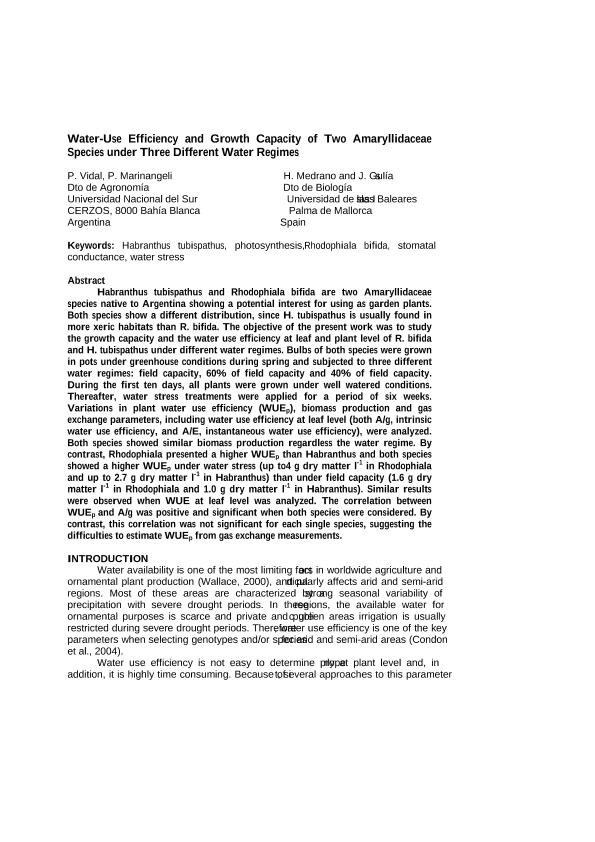Mostrar el registro sencillo del ítem
dc.contributor.author
Vidal, P.
dc.contributor.author
Marinangeli, Pablo Alejandro

dc.contributor.author
Medrano, H.
dc.contributor.author
Gulias, J.
dc.date.available
2015-07-27T15:25:05Z
dc.date.issued
2013-07
dc.identifier.citation
Vidal, P.; Marinangeli, Pablo Alejandro; Medrano, H.; Gulias, J.; Water-Use Efficiency and Growth Capacity of Two Amaryllidaceae Species under Three Different Water Regimes; International Society for Horticultural Science; Acta Horticulturae; 1000; 1; 7-2013; 223-227
dc.identifier.issn
0567-7572
dc.identifier.uri
http://hdl.handle.net/11336/1513
dc.description.abstract
Habranthus tubispathus and Rhodophiala bifida are two Amaryllidaceae species native toArgentina showing a potential interest for using as garden plants. Both species show a different distribution, since H. tubispathus is usually found in more xeric habitats than R. bifida . The objective of the present work was to study the growth capacity and the water use efficiency at leaf and plant level of R. bifida and H. tubispathus under different water regimes. Bulbs of both species were grownin pots under greenhouse conditions during spring and subjected to three different water regimes: field capacity, 60% of field capacity and 40% of field capacity. During the first ten days, all plants were grown under well watered conditions. Thereafter, water stress treatments were applied for a period of six weeks. Variations in plant water use efficiency (WUE p ), biomass production and gas exchange parameters, including water use efficiency at leaf level (both A/g, intrinsic water use efficiency, and A/E, instantaneous water use efficiency), were analyzed. http://aladee.org/Both species showed similar biomass production regardless the water regime. By contrast, Rhodophiala presented a higher WUE p than Habranthus and both species showed a higher WUE p under water stress (up to4 gdry matter l-1 in Rhodophiala and up to 2.7 g dry matter l -1 in Habranthus ) than under field capacity (1.6 g dry matter l - 1 in Rhodophiala and 1.0 gdry matter l-1 in Habranthus). Similar results were observed when WUE at leaf level was analyzed. The correlation between WUEp and A/g was positive and significant when both species were considered. By contrast, this correlation was not significant for each single species, suggesting the difficulties to estimate WUE p from gas exchange measurements.
dc.format
application/pdf
dc.language.iso
eng
dc.publisher
International Society for Horticultural Science
dc.rights
info:eu-repo/semantics/openAccess
dc.rights.uri
https://creativecommons.org/licenses/by-nc-sa/2.5/ar/
dc.subject
Photosynthesis
dc.subject
Stomatal Conductance
dc.subject
Water Stress
dc.subject
Habranthus Tubispathus
dc.subject.classification
Agricultura

dc.subject.classification
Agricultura, Silvicultura y Pesca

dc.subject.classification
CIENCIAS AGRÍCOLAS

dc.title
Water-Use Efficiency and Growth Capacity of Two Amaryllidaceae Species under Three Different Water Regimes
dc.type
info:eu-repo/semantics/article
dc.type
info:ar-repo/semantics/artículo
dc.type
info:eu-repo/semantics/publishedVersion
dc.date.updated
2016-03-30 10:35:44.97925-03
dc.journal.volume
1000
dc.journal.number
1
dc.journal.pagination
223-227
dc.journal.pais
Bélgica

dc.journal.ciudad
Leuven
dc.description.fil
Fil: Vidal, P.. Universidad Nacional del Sur; Argentina
dc.description.fil
Fil: Marinangeli, Pablo Alejandro. Consejo Nacional de Investigaciones Científicas y Técnicas. Centro Científico Tecnológico Conicet - Bahía Blanca. Centro de Recursos Naturales Renovables de la Zona Semiárida. Universidad Nacional del Sur. Centro de Recursos Naturales Renovables de la Zona Semiárida; Argentina
dc.description.fil
Fil: Medrano, H.. Universidad de Las Islas Baleares; España;
dc.description.fil
Fil: Gulias, J.. Universidad de Las Islas Baleares; España;
dc.journal.title
Acta Horticulturae

dc.relation.alternativeid
info:eu-repo/semantics/altIdentifier/url/http://www.actahort.org/books/1000/
Archivos asociados
